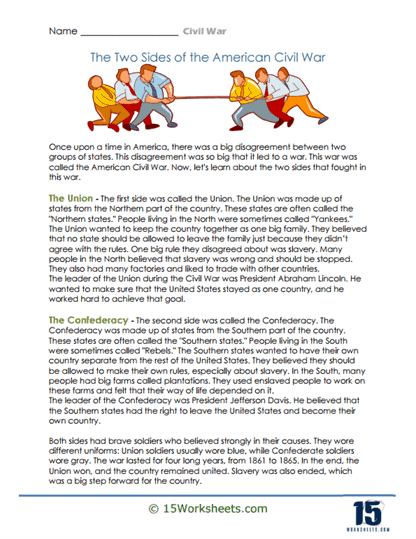

These worksheets cover a wide range of topics – from major battles and prominent figures to broader themes such as the reasons for the war, its outcomes, and its lasting effects. Designed to cater to different learning styles and age groups, these worksheets combine informative content with interactive exercises.
The American Civil War, fought from 1861 to 1865, remains one of the most transformative and poignant periods in the nation’s history. This conflict, which centered on issues of slavery, state rights, and national unity, led to profound political, cultural, and societal shifts.
Timelines and Maps – Students might be asked to create or complete a timeline of major events leading up to, during, and following the Civil War. This provides a chronological perspective of the war’s progression. Using maps, students can identify significant battle sites, Union and Confederate states, and other key geographical points related to the war.
Multiple Choice Questions – These assess general knowledge, asking questions like “Who was the president of the Confederate States of America?” or “Where was the final surrender of the Confederate army?” Students can answer questions on various topics, ranging from the significance of a particular battle to the role of women during the war.
Biographical Sketches – Focusing on key figures such as Abraham Lincoln, Robert E. Lee, or Harriet Tubman, students can write or fill in details about their lives, contributions, and significance. Students can examine firsthand accounts, speeches, letters, or photographs from the era, answering questions or reflecting on the sentiments expressed therein.
Essay Prompts – Encouraging deeper reflection, prompts might ask students to discuss the causes of the Civil War, the role of slavery, or the effects of Reconstruction. Students might be guided to discuss contentious issues of the time, such as states’ rights versus federal authority or the moral implications of slavery. Worksheets may provide scripts or scenarios where students can enact key events, negotiations, or battles, offering an immersive learning experience.
The Civil War played a pivotal role in shaping America’s national identity. By studying it, students gain insights into the struggles and sacrifices that went into forging the nation they know today. As a central issue of the Civil War, understanding slavery is essential. It allows students to explore its socio-economic ramifications, its moral implications, and its lasting societal impacts, including the roots of systemic racism.
The post-war Reconstruction era brought about significant amendments to the U.S. Constitution, notably the 13th, 14th, and 15th amendments, which respectively abolished slavery, granted citizenship to all persons born in the U.S., and gave African American men the right to vote. Understanding these changes helps students appreciate the evolution of civil rights in the U.S.
Analyzing the varied causes of the war, the motivations of its participants, and the experiences of civilians helps students develop both critical analytical skills and empathy for those who lived through those tumultuous times. The repercussions of the Civil War are still felt today, from debates over Confederate monuments to ongoing dialogues about race and equality. By learning about the Civil War, students can better understand and engage in contemporary discussions.
The Civil War resulted in significant loss of life and devastation. By studying it, students can reflect on the costs of war and the value of diplomacy and dialogue. Delving into the Civil War requires students to engage with a range of primary and secondary sources, honing their research and analytical skills.
Beyond merely learning facts and dates, studying the Civil War encourages students to think critically about issues of race, governance, morality, and identity. In understanding this seminal event, students gain not only historical perspective but also a deeper appreciation for the complexities and challenges of the present day.